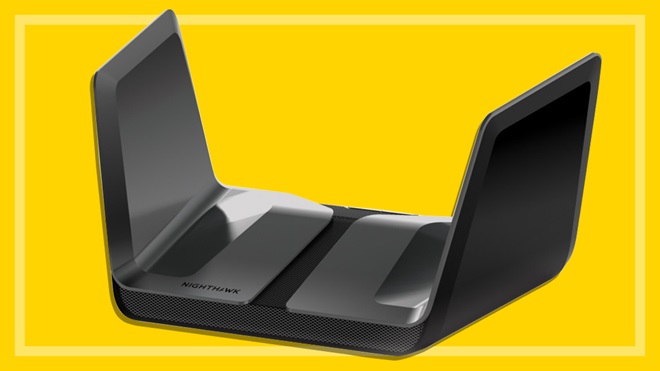CHOICE verdict
Netgear's new Nighthawk AX8 wireless router is one of the first to use the new Wi-Fi 6 (802.11ax) standard, but it boosts network speed even for connected devices still using the older Wi-Fi 5 (802.11ac). Its full potential in providing greater security and supporting more devices will be realised as other devices also upgrade to Wi-Fi 6. Meanwhile, it's a performance booster, and future-proofs your home network.
Price: $600
Contact: netgear.com.au
Wi-Fi 6 is the new name for the new standard for wireless networking (Wi-Fi), also known as 802.11ax, and Netgear is fast off the mark with three next-generation Wi-Fi 6 offerings.
Heading the performers is the Nighthawk AX8 8-Stream AX6000 Wi-Fi 6 Router (RAX80). There's also a four-stream RAX40 ($400) and a 12-stream RAX12 model ($800).
We borrowed Nighthawk AX8 from Netgear to see how much better Wi-Fi 6 is over the current standard that most people use, Wi-Fi 5 (802.11ac). The good news is that you don't need to even have Wi-Fi 6 on your other devices to get a decent performance benefit.
More speed for all
Among the benefits of Wi-Fi 6 is faster speed, lower latency, stronger security and support for more devices. The average Australian home has multiple wireless devices using streaming audio and video, online gaming, plus a growing range of always cloud-connected IoT (internet of things) devices such as home appliances and security gadgets.
The Nighthawk AX8 is a dual-band (2.4GHz and 5GHz) wireless router that can connect to your internet gateway (modem or modem-router). Since most home devices still use Wi-Fi 5 (802.11ac), we tested its performance using several 802.11ac devices.
We found the Nighthawk AX8's 802.11ac speed matches its streamlined look. It's the fastest wireless router we've tested, with an average transfer rate of 72.4MBps (megabytes per second) on the 5GHz band and 23.3MBps on the 2.4GHz band.
Fast with Wi-Fi 5, even faster with Wi-Fi 6
It also excelled when transmitting through walls and over long distances, for both the 2.4GHz and 5GHz bands. It's clear that this router can improve the performance of a regular network using current hardware (802.11ac adapters).
This took a little fiddling though. Out of the box, the performance wasn't optimal. We had to play with the settings in the router to enable a faster rate for 802.11ac in order to get up to the speeds we expected.
As with all wireless routers, 2.4GHz speeds are more easily affected by interference from other 2.4GHz devices and even microwaves. We found that switching to a different channel in the router boosted our 2.4GHz speed, but removing interference gave the best results.
CHOICE tip: For highest performance, stick to the 5GHz band wherever possible.
We found even faster results when paired with other Wi-Fi 6 devices. For example, pairing the router with a latest model Acer Nitro 5 laptop that was equipped with an Intel Wi-Fi 6 AX200 160MHz wireless module produced a transfer speed of 73MBps. This was 10MBps more than we were able to attain using Wi-Fi 5 on the same laptop. This is very fast for wireless networking. To put this in perspective, using a Gigabit ethernet wired connection can transfer at a maximum rate of 109MBps.
The benefits of Wi-Fi 6 routers such as Netgear's will be come more obvious as your home eventually becomes populated with more Wi-Fi 6 client devices. You'll be able to transfer data at a quicker rate, and to more devices at the same time.
Setting up
Setting up the router was not overly difficult and should be fairly easy for most non-technical people. The interface is not the usual Netgear design, with the splashes of colour gone, but the layout remains similar.
Changes to the SSID (your network name), password, and channels can be made from the same page for both bands. A good point for your security is that you are asked to change the admin password for the router itself before you do anything else.
NAS features
For media streaming and file sharing, external drives can be attached to the router's USB 3.0 ports. Netgear's internet-based ReadyCLOUD service can be used to access these drives remotely, effectively making the drives NAS (network-attached storage) units.
A feature called ReadyShare Vault can be used to back up a Windows PC to an attached USB drive.
For content control, you can set keyword or domain name filtering, while Internet rules allows you to enable schedules for Internet access according to the time and day. Access control can be used to enable and disable Internet access to attached devices.
If you're looking for a new router it's a good idea to make sure it's a Wi-Fi 6 model and the Nighthawk range has first points on the board as a powerful and versatile contender.
We're on your side
For more than 60 years, we've been making a difference for Australian consumers. In that time, we've never taken ads or sponsorship.
Instead we're funded by members who value expert reviews and independent product testing.
With no self-interest behind our advice, you don't just buy smarter, you get the answers that you need.
You know without hesitation what's safe for you and your family. And our recent sunscreens test showed just how important it is to keep business claims in check.
So you'll never be alone when something goes wrong or a business treats you unfairly.
Learn more about CHOICE membership today
Stock images: Getty, unless otherwise stated.



